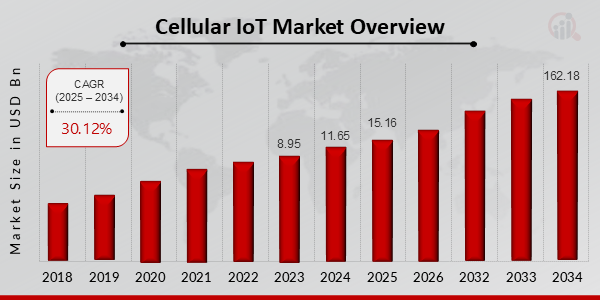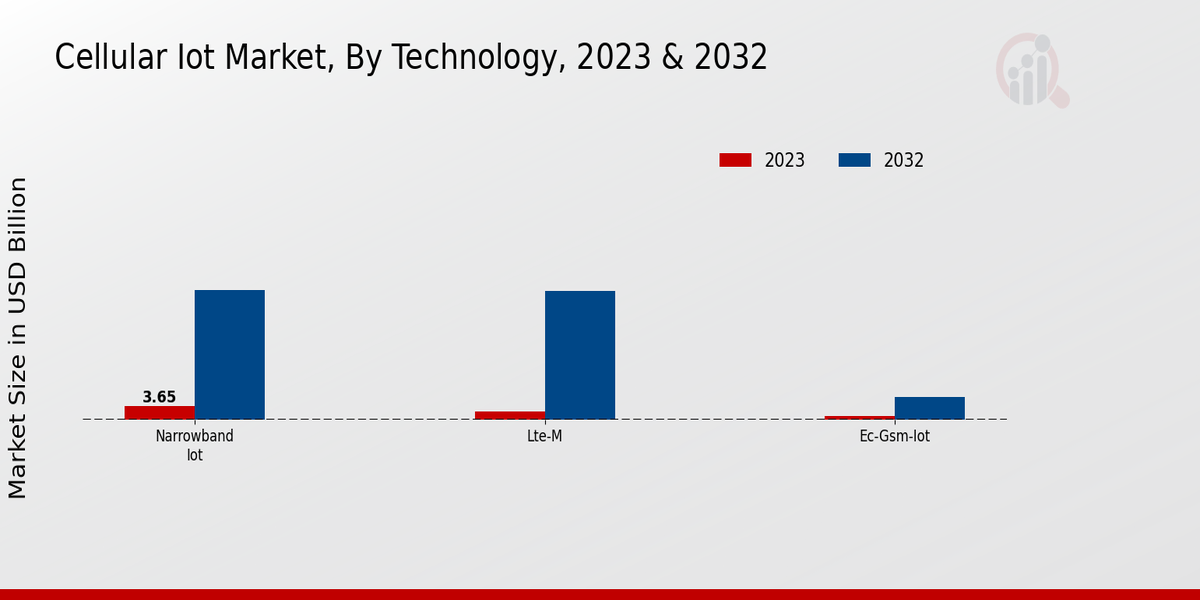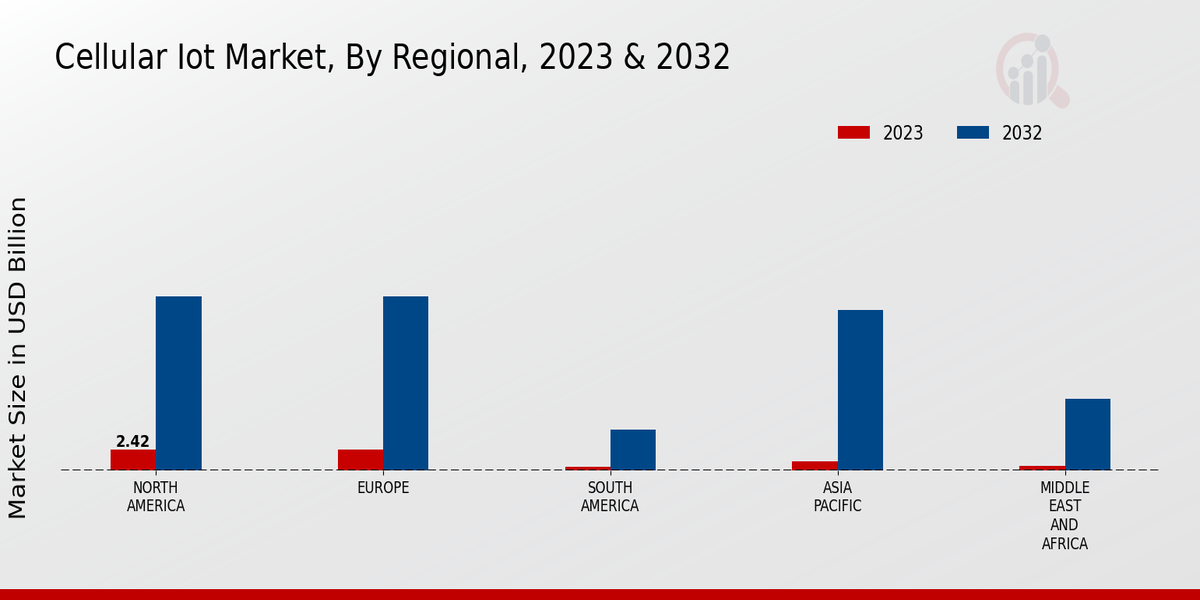Cellular IoT Market Overview
Cellular IoT Market is projected to grow from USD 15.16 Billion in 2025 to USD 162.18 Billion by 2034, exhibiting a compound annual growth rate (CAGR) of 30.12% during the forecast period (2025 - 2034). Additionally, the market size for Cellular IoT Market was valued at USD 11.65 billion in 2024.
Key Cellular IoT Market Trends Highlighted
Cellular IoT, a key technology enabling the Internet of Things (IoT), is experiencing significant growth and adoption. Cellular IoT connects devices and sensors to cellular networks, allowing them to transmit data wirelessly. The market is driven by increasing demand for IoT applications in various industries, including utilities, manufacturing, healthcare, and transportation.
Moreover, the expansion of 5G networks, offering higher speeds and lower latency, is expected to further fuel the growth of Cellular IoT. The Cellular IoT market is characterized by advancements in cellular technologies, such as NB-IoT and LTE-M, which provide low-power and wide-area coverage for IoT devices. Additionally, the emergence of edge computing and cloud services enables real-time data processing and analytics, enhancing the capabilities of Cellular IoT solutions. The market is witnessing consolidation, with major cellular network operators acquiring smaller IoT service providers to strengthen their offerings.
To capture opportunities, market players focus on partnerships and collaborations to develop comprehensive IoT solutions. They are investing in research and development to enhance network infrastructure and device capabilities. The market is expected to see increased adoption in smart city deployments, where Cellular IoT is used for applications such as traffic management, environmental monitoring, and public safety.
Figure 1: Cellular IoT Market Size, 2025-2034 (USD Billion)

Source: Primary Research, Secondary Research, MRFR Database and Analyst Review
Cellular IoT Market Drivers
Increasing Adoption of IoT Devices
One of the main drivers of the Cellular IoT Market is the increasing number of Internet of Things devices. These devices require a reliable and secure connection to transmit data, and Cellular IoT networks provide such a connection.
It is low latency, covers a wide area, and is highly reliable. Thus, Cellular IoT networks are ideal for such Internet of Things applications as tracking assets, remote monitoring, and building a smart city infrastructure.
Moreover, as the number of IoT devices grows, the number of these connections will also grow. It is safe to assume that the growth of IoT network connections will continue to drive the Cellular IoT Market.
There are several key factors that led to the growing adoption and number of IoT devices: cost reduction of sensors and rent of Internet of Things connectivity, improved cloud computing platforms that allow easy storage, and analysis.
Additionally, many governments also implement policies or initiatives designed to increase the number of IoT devices. These devices could help to reduce the environmental impact of human activity, lower pollution and waste, and have many other practical uses.
Overall, the Cellular IoT Market will continue to see growth and it is expected to happen at a faster rate in emerging markets, as the number of IoT devices is lower there.
Government Initiatives and Regulations
Government initiatives and regulations are another important driver of the growth of the Cellular IoT Market. Governments around the world are increasingly recognizing the potential of IoT to improve public services, boost economic growth, and create new jobs.
As a result, many governments are implementing policies and regulations to promote the adoption of IoT devices and Cellular IoT networks.
For example, the European Union has launched a number of initiatives to support the development of the IoT market, including the Connecting Europe Facility and the Digital Single Market Strategy.
The United States government has also made IoT a priority, with the Federal Communications Commission (FCC) allocating spectrum for IoT use and the National Institute of Standards and Technology (NIST) developing standards for IoT security.
Government initiatives and regulations are providing a supportive environment for the growth of the Cellular IoT Market. By promoting the adoption of IoT devices and Cellular IoT networks, governments are helping to create a more connected and efficient world.
Technological Advancements
The Cellular IoT Market is also driven by technological advancements. Cell IoT technology is becoming more efficient and capable thanks to innovations such as 5G, NB-IoT, and LTE-M. These technologies allow for real-time monitoring, predictive maintenance, and remote control.
The market is also growing as a result of the development of new IoT platforms and applications. Businesses can make it easier to connect and manage their devices by using these platforms and applications, and they can also gain insights from the data they collect. Technological advancements are the catalyst for the Cellular IoT Market to grow.
Better performance, efficiency, and connectivity will enable new applications and use cases, and will also make it easier for businesses to adopt IoT.
Cellular IoT Market Segment Insights
Cellular IoT Market Technology Insights
The technology segment of the Cellular IoT Market is categorized into Narrowband IoT (NB-IoT), LTE-M, and EC-GSM-IoT. Each technology caters to specific application requirements and offers unique advantages and limitations.
Narrowband IoT (NB-IoT) is a low-power wide-area network (LPWAN) technology designed for low-power devices with limited data requirements.
It operates in an unlicensed spectrum and provides extended coverage with deep indoor penetration, making it suitable for applications such as smart metering, asset tracking, and remote monitoring.
The Cellular IoT Market revenue for NB-IoT is projected to reach USD 10.28 billion by 2024, growing at a CAGR of 27.3%. LTE-M (Long Term Evolution for Machines) is another LPWAN technology that offers higher data rates and lower latency compared to NB-IoT.
It operates in a licensed spectrum and provides enhanced security and reliability, making it suitable for applications such as connected vehicles, industrial automation, and smart cities. The Cellular IoT Market data for LTE-M is estimated to reach USD 6.34 billion by 2024, growing at a CAGR of 31.4%.
EC-GSM-IoT (Extended Coverage GSM-IoT) is a variant of GSM technology optimized for IoT applications. It provides wide coverage, low power consumption, and low cost, making it suitable for applications such as smart metering, asset tracking, and remote monitoring in remote areas.
The Cellular IoT Market Statistics for EC-GSM-IoT is projected to reach USD 2.76 billion by 2024, growing at a CAGR of 24.5%. The Cellular IoT Market is witnessing rapid growth due to the increasing adoption of IoT devices across various industries.
The market growth is driven by factors such as the need for efficient connectivity, improved operational efficiency, and enhanced customer experiences. The market is expected to continue expanding in the coming years, with new technologies and applications emerging to further drive market expansion.

Source: Primary Research, Secondary Research, MRFR Database and Analyst Review
Cellular IoT Market Application Insights
First, the application segment has significant weight in the Cellular IoT Market. Namely, Smart Metering, Asset Tracking, and Fleet Management applications contribute largely to the overall market development.
Particularly, Smart Metering is projected to be a successful application in terms of market revenue, which will rise above $15.6 billion by 2024.
The growth is conditioned by the increasingly growing demand for efficient energy consumption and smart grid infrastructure. Moreover, Asset Tracking is also a vital application for the market since the market data prospects its revenue generation to go beyond $12.8 billion by 2024.
The growing application of technology in terms of real-time asset visibility and tracking and its optimization in different industries will define the trend.
Finally, fleet Management is currently gradually becoming a trending market application, and the statistics show it will raise above 10.4 billion by 2024. The shift is conditioned by the adoption of IoT solutions for a vehicle, driver, and fleet optimization, safety, and effectiveness.
Cellular IoT Market End User Insights
The Cellular IoT Market Segmentation by End User into Industrial, Utilities, and Consumer provides valuable insights into the target customer base and their specific requirements.
The Industrial segment is projected to hold a significant share of the market in 2024, driven by the increasing adoption of Cellular IoT solutions for remote monitoring, asset tracking, and predictive maintenance in manufacturing, mining, and transportation industries.
The Utilities segment is also expected to witness steady growth, with Cellular IoT enabling smart grid management, remote metering, and leak detection for efficient energy distribution.
The Consumer segment is anticipated to gain traction in the coming years as Cellular IoT enhances personal safety, health monitoring, and home automation applications.
Overall, the Cellular IoT Market segmentation offers granular data and insights, allowing stakeholders to tailor their strategies and capitalize on growth opportunities in specific end-user verticals.
Cellular IoT Market Deployment Model Insights
The deployment model segment of the Cellular IoT Market is divided into public and private. The public deployment model held a larger market share in 2023, owing to the increasing adoption of Cellular IoT solutions by network operators and service providers.
The public deployment model offers benefits such as scalability, reliability, and cost-effectiveness, making it an attractive option for large-scale IoT deployments.
The private deployment model, on the other hand, is expected to witness significant growth in the coming years due to the rising demand for secure and customized IoT solutions.
Private networks provide greater control over network infrastructure and data security, which is essential for critical IoT applications in industries such as manufacturing, healthcare, and energy.
Cellular IoT Market Regional Insights
The Cellular IoT Market is segmented regionally into North America, Europe, APAC, South America, and MEA. In 2023, North America held the largest market share of 35%, primarily attributed to the early adoption of Cellular IoT technology and the presence of prominent industry players.
Europe is projected to witness the highest CAGR of 32% during the forecast period, driven by government initiatives and the increasing demand for IoT solutions in various industries.
APAC is expected to account for the second-largest market share by 2032, with a significant contribution from countries like China, Japan, and India.
South America and MEA are anticipated to witness steady growth, supported by increasing investments in infrastructure and the adoption of Cellular IoT for smart city applications.

Source: Primary Research, Secondary Research, MRFR Database and Analyst Review
Cellular IoT Market Key Players and Competitive Insights
Major players in the Cellular IoT Market are continuously investing in research and development to offer advanced solutions and expand their market presence. Strategic partnerships, mergers, and acquisitions are other key strategies adopted by leading Cellular IoT Market players to gain a competitive edge.
The Cellular IoT Market landscape is characterized by intense rivalry, with numerous established and emerging players competing for market share.
Leading Cellular IoT Market players are focusing on expanding their global footprint by establishing partnerships and strategic alliances with local players in emerging markets. These partnerships allow them to leverage local knowledge, distribution channels, and expertise to cater to specific regional requirements.
Qualcomm is a leading player in the Cellular IoT Market, offering a comprehensive portfolio of chipsets, modems, and IoT solutions. The company holds a significant market share and has a strong presence in key vertical markets such as automotive, healthcare, and industrial automation.
Qualcomm's commitment to innovation and its wide range of solutions have enabled it to maintain a strong competitive position in the Cellular IoT Market.
A key competitor in the Cellular IoT Market is Ericsson, which provides a range of Cellular IoT connectivity solutions, including modules, gateways, and network infrastructure. Ericsson has a strong presence in the telecommunications industry and has established partnerships with major mobile network operators worldwide.
The company's focus on providing end-to-end IoT solutions and its global reach has contributed to its success in the Cellular IoT Market. Ericsson is continuously investing in research and development to enhance its IoT offerings and expand its market share.
Key Companies in the Cellular IoT Market Include:
- ZTE
- Intel
- Qualcomm
- Nokia Corporation
- ublox
- AT
- Gemalto
- Sequans Communication
- Huawei Technologies
- Vodafone Group
- Sierra Wireless
- Thales Group
- Verizon
- Rogers Communications
- Ericsson
Cellular IoT Market Developments
The growing adoption of IoT devices across various industries, increasing demand for low-power wide-area networks (LPWANs), and government initiatives supporting smart city development are major factors driving market growth.
Key market players are focusing on developing innovative solutions to cater to the diverse needs of end-users.
For instance, in February 2023, Qualcomm Technologies, Inc. announced the launch of its latest IoT modem, the Qualcomm 315 5G IoT Modem, designed to support extended reality (XR) and industrial IoT applications.
Cellular IoT Market Segmentation Insights
-
Cellular IoT Market Technology Outlook
- Narrowband IoT (NB-IoT)
- LTE-M
- EC-GSM-IoT
-
Cellular IoT Market Application Outlook
- Smart Metering
- Asset Tracking
- Fleet Management
-
Cellular IoT Market End User Outlook
- Industrial
- Utilities
- Consumer
-
Cellular IoT Market Deployment Model Outlook
-
Cellular IoT Market Regional Outlook
- North America
- Europe
- South America
- Asia Pacific
- Middle East and Africa
| Report Attribute/Metric |
Details |
|
Market Size 2024
|
11.65 (USD Billion)
|
|
Market Size 2025
|
15.16 (USD Billion)
|
|
Market Size 2034
|
162.18 (USD Billion)
|
|
Compound Annual Growth Rate (CAGR)
|
30.12% (2025 - 2034)
|
|
Report Coverage
|
Revenue Forecast, Competitive Landscape, Growth Factors, and Trends
|
|
Base Year
|
2024
|
|
Market Forecast Period
|
2025 - 2034
|
|
Historical Data
|
2019 - 2023
|
|
Market Forecast Units
|
USD Billion
|
| Key Companies Profiled |
ZTE, Intel, Qualcomm, Nokia Corporation, ublox, AT, Gemalto, Sequans Communication, Huawei Technologies, Vodafone Group, Sierra Wireless, Thales Group, Verizon, Rogers Communications, Ericsson |
| Segments Covered |
Technology, Application, End User, Deployment Model, Regional |
| Key Market Opportunities |
Smart city infrastructure expansion Industrial IoT applications Growth of NB IoT and LTEM Rising demand for connected devices 5G network rollouts |
| Key Market Dynamics |
Rising demand for connected devices Government initiatives Technological advancements Increasing adoption of Industry 4.0 Growing awareness of Cellular IoT solutions |
| Countries Covered |
North America, Europe, APAC, South America, MEA |
Frequently Asked Questions (FAQ) :
The Cellular IoT Market is anticipated to reach an overall valuation of approximately 6.88 billion USD in 2025.
By 2034, the Cellular IoT Market is forecasted to attain an impressive valuation of around 162.18 billion USD.
Cellular IoT Market is expected to maintain a robust Compound Annual Growth Rate (CAGR) of approximately 30.12% during the period from 2025 to 2034.
The Asia Pacific region, particularly China, is anticipated to be a key driver of growth in the Cellular IoT Market due to the increasing adoption of IoT devices and government initiatives supporting smart city development.
Cellular IoT technology finds applications in various sectors, including smart cities, healthcare, transportation, manufacturing, and agriculture, enabling real-time data collection, remote monitoring, and automated control.
Major players in the Cellular IoT Market include Ericsson, Huawei, Nokia, Qualcomm, and Sierra Wireless, among others.
The growth of the Cellular IoT Market is primarily driven by the increasing demand for IoT devices, the expansion of 5G networks, and government initiatives promoting smart city development.
Challenges in the Cellular IoT Market include concerns over data security and privacy, the need for interoperability standards, and the limited availability of skilled professionals.
The advent of 5G technology is expected to revolutionize the Cellular IoT Market by providing faster data speeds, lower latency, and increased network capacity, enabling the deployment of more sophisticated IoT applications.
Future trends in the Cellular IoT Market include the integration of artificial intelligence (AI) and machine learning (ML) for enhanced data analysis and predictive maintenance, the development of low-power wide-area (LPWA) technologies for extended battery life, and the emergence of new applications in areas such as autonomous vehicles and smart homes.

















